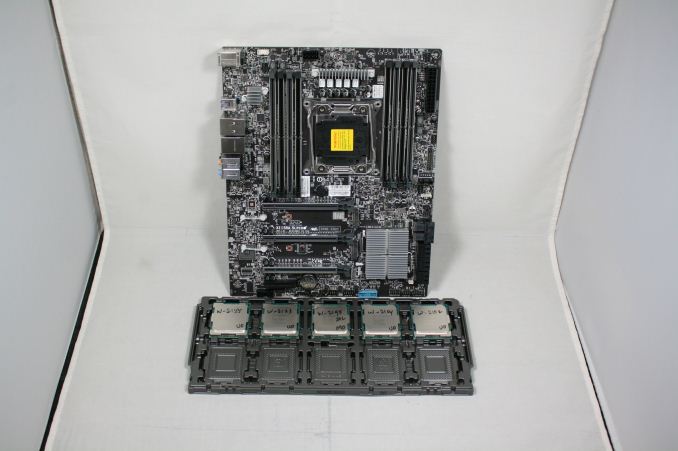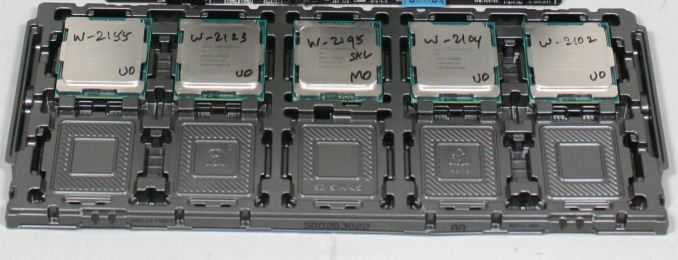The Intel Xeon W Review: W-2195, W-2155, W-2123, W-2104 and W-2102 Tested
by Ian Cutress & Joe Shields on July 30, 2018 1:00 PM EST- Posted in
- CPUs
- Intel
- Xeon
- Workstation
- ECC
- Skylake-SP
- Skylake-X
- Xeon-W
- Xeon Scalable
Conclusion: Is Intel Serious About Xeon W?
In this review, we have covered the performance on three of the more popular Xeon W processors, as well as two off-roadmap parts, and discussed that the Intel’s decision to bifurcate the way its workstation and consumer processors work has put more questions on the table for prospective buyers.
This ultimately comes down to the question: Is Intel Serious About Xeon W? If we ask Intel about this, of course the answer to them is yes – they want to have target markets and have a product portfolio that they feel will fit with that user base. However I am not so sure.
Xeon W was launched a lot later than both the Xeon Scalable platform and the equivalent Skylake-X consumer platform. The messaging behind Xeon W is unclear to a large degree, with only a limited amount of PR invested into it, unlike Xeon Scalable or Skylake-X. The decision to split the market between consumer and workstation, despite having a common socket, has minimized the accessibility of the workstation platform: fewer discussions are being had about the hardware, because there’s little room for a truly mix-and-match scenario as with previous generations. At no point in Intel’s messaging were we offered review samples for example, which is usually an indication that the product line is not one that the product managers are looking to promote. Only Intel’s latest Xeon E designs, released 10 months after the first equivalent consumer parts, beats Xeon W in terms of how un-exciting it can be to try and discuss talking about a platform. Intel does not want to sample Xeon E, either.
So will Intel lose workstation market share to AMD? If I am being so pallid, what are the financial ramifications for this market? AMD’s Threadripper looks like an appealing platform for workstation users for sure, but AMD is not without its own issues. Intel is the incumbent, and has embedded itself with a large number of OEMs and end-users for years, making it difficult for AMD to break that market. AMD’s chiplet design will take a few generations to get used to, so users might stick with ‘what they know’, regardless of any cost/benefit analysis. There is also the discussion of ECC support on Threadripper, for which the messaging has been somewhat unclear: technically it should support up to ECC LRDIMMs, however it does depend a lot on whether the motherboard vendor has qualified their product for RDIMMs or LRDIMMs – most of them are not, complicating the issue. If AMD wanted to tackle this space, they need an ASUS or a GIGABYTE to build a ‘workstation focused’ motherboard, with confirmed ECC and co-processor support. GIGABYTE’s Designare line and MSI’s upcoming X399 Creation might be aimed at this, but it really does require a razor-sharp message to get through.
All this confusion means that while AMD can be competitive in most tests, Intel is expected to remain the market leader for the foreseeable future.
I’m Sold on Xeon W: Tell Me About Performance
As our benchmarks are anything to go by, there is a lot of parity in performance between Intel’s Xeon W and Intel’s Skylake-X product lines. Xeon W takes a hit in memory workloads, because of the memory support: ECC RDIMMs are typically run at base JEDEC sub-timings, and so our DDR4-2666 memory was run at 19-19-19, compared to the 16-16-17 on the consumer platform which is more typical.
Our Xeon W results are skewed a bit towards the low-end processors, mostly because three of the five units we managed to acquire were quad-core processors. At this level, Intel’s now EOL Kaby Lake-X processors fared better, or the consumer Coffee Lake-S look like the better option, unless the user needs ECC or more PCIe lanes than the consumer products provide. The obvious counterpoint here is that if a user needs ECC, and is happy with 64 GB maximum memory support, then Intel’s own Xeon E is also an option, however we have not tested those parts yet (if any OEM can sample them to us, please let us know).
On the high-end, we do see the W-2195 sit behind the Core i9-7980XE in almost all benchmarks, which also means that for embarrassingly parallel workloads, it also sits behind the Threadripper 1950X. It still holds that Intel’s single threaded performance of the Xeon W, despite the lack of Turbo Boost 3.0, still gives it a significant advantage in single threaded workloads over AMD.
For users worrying about Spectre and Meltdown patches affecting performance, in our SYSMark tests we saw a 2-6% decrease over all the tests, with the hardest hit tests seeing a 12% decrease due to the correlation with storage.
Why Buy Xeon W?
The obvious reasons to buy Xeon W processors are just tick boxes: ECC memory, PCIe lanes, co-processor verification. If these are needed, the number of options for the rest of the system (particularly the motherboard) becomes slim, especially when factoring in price and total cost of ownership. A lot of the workstation market works on development cycles and high-throughput compute: the faster the compute, the quicker the prototyping. The fastest processors for a lot of that work, if CPU bound, are won by the consumer Core i9 or Threadripper, however if the above boxes are ticked, then Xeon W would be needed. Or Xeon Scalable, depending on budget.
A small side note to end: If anyone has access to any of the Apple-only Xeons (like the W-2150B) and would kindly let us borrow it for a review, please let me know over email.












74 Comments
View All Comments
0ldman79 - Tuesday, July 31, 2018 - link
Agreed.I imagine there will be several situations where the 6 core 12 thread i7 will outperform the i9 9700.
If the cache increase is enough that may not happen, but I'm not betting on it making up enough of a difference.
Icehawk - Friday, August 3, 2018 - link
The 8086 is functionally equivalent to the 8700, they trade blows in a pretty tight grouping so I don’t mind that they used it’s scores.mode_13h - Monday, July 30, 2018 - link
Their pricing is nuts! These can only make sense if you're desperate for PCIe lanes or lots of cores (and, for some reason, don't want AMD).I have an older E5 Xeon and wanted to replace it with a W-series, but I can't justify this pricing (or the performance hit taken on the lower-core-count models, relative to desktop/E-series chips). I will have to opt for either an E-series Xeon or a Ryzen. At this rate, I see myself going for a 7 nm Ryzen, actually.
I think AMD is smart for using narrow AVX units. > 256-bit doesn't really make sense for much that wouldn't be better-served by a GPU. AVX-512 was a strategic misstep for Intel, and they're just going to have to live with it.
mode_13h - Monday, July 30, 2018 - link
Oh, and let's not forget the IHS TIM issue.I'm not in the market for > 8 cores, but those who are will be disappointed by the rate of thermal throttling, due to this being their first (recent) workstation/HEDT chip with a non-soldered IHS.
0ldman79 - Tuesday, July 31, 2018 - link
I missed that.The IHS is using TIM even on the Xeon now?
That was honestly the one big reason I was looking at the Xeon. That's just a poor business decision. Xeon carries a price premium, they could at least guarantee the heat conductivity is going to be enough to keep it running cool and smoothly for the life of the chip.
mode_13h - Wednesday, August 1, 2018 - link
I don't know this for a fact, but their Xeons are normally just binned HEDT processors without the special features fused off. So, I assume it's the same crappy TIM under that IHS.Comparing thermal performance @ the same clock for 10+ core models vs the i9's would easily show whether this is true.
HStewart - Monday, July 30, 2018 - link
"I think AMD is smart for using narrow AVX units. > 256-bit doesn't really make sense for much that wouldn't be better-served by a GPU. AVX-512 was a strategic misstep for Intel, and they're just going to have to live with it."AMD's AVX 2 is only 1/2 of Intel AVX 2 - that sound like they are using dual 128 bits instead 256 bits
Also keep in mind Intel CPU also have AVX 2 support your statement makes no sense.
HStewart - Monday, July 30, 2018 - link
https://forums.anandtech.com/threads/ryzens-halved...bill.rookard - Monday, July 30, 2018 - link
The thing is - and this is somewhat critical for a workstation based board, you're NOT really going to be using it for single threaded tasks. You'll be using software which has for the most part SHOULD be multi-threaded. Considering that the Threadripper is a 16c/32t CPU in the gen1, and running for a street price of about $800ish, and the gen2 is going to be a 32c/64t beastie of a CPU at a price of $1500ish, why would you spend $2500 on a 18c/36t Intel CPU?You could just as easily do some research to find people who have indeed put together some TR/ECC combos, and put a complete AMD system for the price of an Intel CPU alone.
mode_13h - Tuesday, July 31, 2018 - link
That's nuts, dude. For software development, I want lotsa cores for parallel builds. When recompiling only a few files, I want fast single-thread perf.The reality is that there are still lots of places in day-to-day computing where single-thread perf matters. I don't know how you can possibly believe you accurately represent the needs of all workstation users, but you don't.